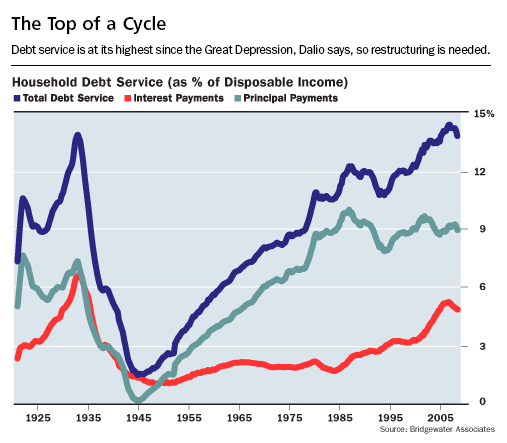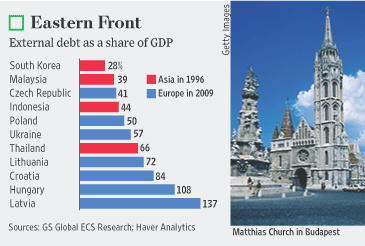No Signs Of A Bottom
The market continues its massive sell off in a resounding vote of no confidence on the measures being taken to reverse the economy’s downward spiral. A contrary investor buying the dips over the past two years has seen nothing but huge losses. Recent news on the economy continues to indicate that things are getting worse, not better. The impact of estimated losses of over $100 trillion in stocks, bonds and real estate over the past two years will not be offset by stimulus plans.
The trillions of dollars being borrowed to prop up the system are being overwhelmed by a loss of confidence and a loss of wealth that many fear may never be recovered. The massive deficit in the national budget (12% of GDP) is causing a sell off in the long treasury market, with yields rising above 3% today on the 10 year bond. The scary question in many people’s minds is how many more trillions of government debt and guarantees will be needed to support a collapsing banking and insurance industry?
Bernanke Confident – Reality Denied
Chairman Bernanke of the Federal Reserve recently expressed his optimistic view that the recession would be over this year – see Do Bernanke and Obama Talk To Each Other? Many others with far superior track records do not agree with Bernanke.
Paul Volcker – former Federal Reserve Chairman – “I don’t remember any time, maybe even in the great depression, when thing went down quite so fast, quite so uniformly around the world”.
George Soros – successful hedge fund investor – the financial system “was placed on life support, and it’s still on life support. There’s no sign that we are anywhere near a bottom”.
Nouriel Roubini – economist who correctly forecast the financial collapse – “We are still in the third and fourth innings and it’s getting worse”.
Logical minds would have to strongly doubt Bernanke’s optimistic view, especially in view of his previous calls that proved to be ridiculous, such as:
“We will follow developments in the subprime market closely. However, fundamental factors—including solid growth in incomes and relatively low mortgage rates—should ultimately support the demand for housing, and at this point, the troubles in the subprime sector seem unlikely to seriously spill over to the broader economy or the financial system.”
—June 5, 2007
Horrific Economic News Continues – Notable Links
California’s Jobless Rate Exceeds 10%
California’s unemployment rate climbed to 10.1% in January, the highest since 1983, as employers in the nation’s most-populous state cut 79,000 jobs in the month.
There were 3.3% fewer jobs in January 2009 compared to January 2008. The report said there were 1,863,000 unemployed Californians in January, up by 754,000 a year earlier.
The first half of 2009 will continue “to be pretty ugly,” said Howard Roth, the chief economist for the state’s finance department.
The state is threatening to pass the 11% jobless rate of late 1982, the highest since the Great Depression. “All we need is another month like this,” Mr. Roth said.
Yet if historians look back on today’s severe downturn, with its crumbling markets, rising unemployment and massive government interventions, they could well be busy analyzing how globalization — the spread of trade, finance, technology and the movement of people around the world — went into reverse. They would likely point to the growth of economic nationalism as the root cause.
The last time we saw sustained economic nationalism was in the 1930s, when capital flows and trade among countries collapsed, and every country went its own way. World growth went into a ditch, political ties among nations deteriorated, nationalism and populism combined to create fascist governments in Europe and Asia, and a world war took place.
It’s no accident that the European Union has called an emergency summit for this Sunday to consider what to do with rising protectionism of all kinds.
There are a number of reasons why economic nationalism could escalate.
As happened in the 1930s, economic nationalism is also sure to poison geopolitics. Governments under economic pressure have far fewer resources to take care of their citizens and to deal with rising anger and social tensions. Whether or not they are democracies, their tenure can be threatened by popular resentment. The temptation for governments to whip up enthusiasm for something that distracts citizens from their economic woes — a war or a jihad against unpopular minorities, for example — is great.
Economy In Worst Fall Since 1982
A broad measure of the U.S. economy plummeted in the fourth quarter — to levels far worse than previously thought — underscoring how quickly the economy has soured and casting doubt that things will get better this year.
With falloffs in consumer spending and exports, gross domestic product declined at a 6.2% annual rate in the fourth quarter of 2008, according to a Commerce Department report Friday. The agency’s first estimate for GDP, reported in January, was for a 3.8% decline. GDP is a key measure of a country’s economic performance.
Does $65.5 trillion terrify anyone yet?
As the Obama administration pushes through Congress its $800 billion deficit-spending economic stimulus plan, the American public is largely unaware that the true deficit of the federal government already is measured in trillions of dollars, and in fact its $65.5 trillion in total obligations exceeds the gross domestic product of the world.
Failure To Save Eastern Europe Will Lead To Worldwide Meltdown
The unfolding debt drama in Russia, Ukraine, and the EU states of Eastern Europe has reached acute danger point.
If mishandled by the world policy establishment, this debacle is big enough to shatter the fragile banking systems of Western Europe and set off round two of our financial Götterdämmerung.Austria’s finance minister Josef Pröll made frantic efforts last week to put together a €150bn rescue for the ex-Soviet bloc. Well he might. His banks have lent €230bn to the region, equal to 70pc of Austria’s GDP.
“A failure rate of 10pc would lead to the collapse of the Austrian financial sector,” reported Der Standard in Vienna. Unfortunately, that is about to happen.
Europe’s governments are making matters worse. Some are pressuring their banks to pull back, undercutting subsidiaries in East Europe. Athens has ordered Greek banks to pull out of the Balkans.
The sums needed are beyond the limits of the IMF, which has already bailed out Hungary, Ukraine, Latvia, Belarus, Iceland, and Pakistan – and Turkey next – and is fast exhausting its own $200bn (€155bn) reserve. We are nearing the point where the IMF may have to print money for the world, using arcane powers to issue Special Drawing Rights.
We are living through a crisis which, from the collapse of Northern Rock and the first intimations of the credit crunch, nobody has been able to understand, let alone grasp its potential ramifications. Each attempt to deal with the crisis has rapidly been consumed by an irresistible and ever-worsening reality.
Yet what if such a crisis were to be no longer confined to the peripheries of global capitalism but instead struck at its heartlands? Now we know the answer. The crisis has enveloped the whole world like an uncontrollable virus, spreading from the US and within a handful of months assuming global proportions, at the same time mutating with frightening speed from a financial crisis into a fully fledged economic crisis.
As General Motors Goes, So Goes The Nation
General Motors was founded in 1908 in Flint, Michigan and grew to be the largest corporation in the world. Its market capitalization reached $50 billion in 2000. In the past week its market capitalization dropped below $1 billion to levels last seen during the 1920’s. The story of General Motors is the story of America.
“I think it is important to recognize that General Motors is a canary in this country’s economic coal mine; a forerunner for what’s to come for the broader economy. Their mistakes have resembled this nation’s mistakes; their problems will be our future problems. If the U.S. and General Motors have similar flaws and indeed symbiotic fates, they appear to be conjoined primarily by the un-competitiveness of their existing labor cost structures and the onerous burden of their future healthcare and pension liabilities. Perhaps the most significant comparison between GM and the U.S. economy lies in the recognition of enormous unfunded liabilities in healthcare and pensions.



